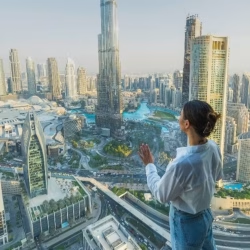Kinkakuji Temple officially known as Rokuonji Temple, is a stunning Zen Buddhist temple located in Kyoto, Japan. Renowned for its breathtaking Golden Pavilion, Kinkakuji is one of the most iconic and visited sites in Japan.
Kyoto, Japan, is a treasure trove of ancient temples and serene gardens. Among these, Kinkakuji Temple, also known as the Golden Pavilion, stands out as a beacon of beauty and cultural significance. This three-story structure, adorned with shimmering gold leaf, reflects perfectly on the still waters of its surrounding pond, creating a picture of exquisite tranquility. A visit to Kinkakuji Temple is a captivating journey through Japanese history, Zen philosophy, and the breathtaking artistry of Kyoto.
Here’s an exploration of its history, architecture, cultural significance, and the experience it offers to visitors:
History and Origins

Kinkakuji Temple’s origins date back to the late 14th century. Here’s a glimpse into its fascinating past:
- From Retirement Villa to Zen Temple: Originally built as a retirement villa for Shogun Ashikaga Yoshimitsu, the complex was converted into a Zen temple after his death according to his wishes.
- A Symbol of Prosperity: The use of gold leaf, a symbol of wealth and power, reflects the prosperity of the Muromachi period when Kinkakuji was built.
- A Site of Resilience: The temple has undergone several fires throughout history, most recently in 1950 by an arsonist. Each time, it has been meticulously rebuilt, showcasing the enduring spirit of its caretakers.
Architecture and Design

- Golden Pavilion: The most striking feature of Kinkakuji is its top two floors, which are completely covered in gold leaf. The pavilion sits elegantly overlooking a large pond, reflecting its golden facade and the surrounding landscape.
- Three-Story Structure: The building itself is structured with each floor representing a different style of architecture. The first floor is in the Shinden style (palace architecture), the second floor in the Bukke style (warrior house), and the third floor in the Zen temple style, crowned with a golden phoenix on top.
Cultural Significance

- Zen Buddhism: Kinkakuji Temple embodies Zen Buddhism principles of simplicity, harmony with nature, and the pursuit of enlightenment. It serves as a peaceful retreat and a place for meditation and contemplation.
- UNESCO World Heritage: In 1994, Kinkakuji was designated a UNESCO World Heritage Site, recognizing its cultural and historical significance as one of the most representative examples of the Muromachi period’s architectural style.
Garden and Surroundings

- Strolling Garden: The temple complex includes meticulously landscaped gardens with paths that lead visitors through a variety of scenic views, including moss gardens, tea houses, and carefully pruned trees.
- Mirror Pond: The reflection of the Golden Pavilion on the Mirror Pond (Kyoko-chi) creates a picturesque scene that enhances the temple’s beauty, especially during the changing seasons.
Kinkakuji Temple Visitor Experience
- Tourism: Kinkakuji Temple attracts a large number of tourists throughout the year, both domestic and international, who come to admire its stunning architecture and serene surroundings.
- Cultural Immersion: Visitors can participate in traditional tea ceremonies held in the tea houses within the temple grounds, offering a deeper understanding of Japanese tea culture and Zen practices.
Modern Relevance
- Cultural Icon: Kinkakuji has become an enduring symbol of Japan’s cultural heritage, featured in literature, films, and popular media, attracting visitors seeking to experience its tranquility and historical significance.
- Conservation and Preservation: Efforts are continuously made to preserve the temple and its surrounding gardens, ensuring that future generations can continue to appreciate its beauty and historical value.
Kinkakuji Temple remains an enchanting destination that captivates visitors with its timeless elegance, profound spiritual atmosphere, and breathtaking golden architecture, making it a must-see attraction for anyone visiting Kyoto, Japan.
Beyond the Golden Facade
While the gold leaf facade is undoubtedly Kinkakuji’s most striking feature, the temple complex offers more to explore:
- The Rokuonji Temple Complex: Kinkakuji is part of a larger temple complex called Rokuonji. While only the Golden Pavilion is accessible to the public, the serene gardens surrounding the pond offer a peaceful respite.
- The Kyokuho-jo (Pavilion of the Golden Crane): A smaller teahouse adorned with gold leaf flakes sits opposite the Golden Pavilion.
- A Reflection of Zen Philosophy: The garden’s design and the placement of the Golden Pavilion embody the principles of Zen Buddhism, emphasizing harmony, balance, and reflection.
Kinkakuji Temple – A Journey for the Senses
A visit to Kinkakuji Temple is an experience that engages all the senses:
- Visual Spectacle: The gleaming gold facade and the perfect reflection on the pond create a breathtaking visual spectacle.
- Tranquil Atmosphere: The serene gardens and the gentle sounds of water create a calming atmosphere, perfect for quiet contemplation.
- Cultural Immersion: Exploring Kinkakuji offers a window into Japanese history, architecture, and Zen philosophy.
Planning Your Visit to Kinkakuji Temple

Kinkakuji Temple is one of Kyoto’s most popular tourist attractions. Here are some tips for a smooth visit:
- Purchase tickets online: Tickets can be purchased online to avoid long queues, especially during peak season.
- Respect the tranquility: Kinkakuji is a place of worship; maintain a respectful volume and avoid using flash photography inside the temple grounds.
- Combine your visit with other attractions: Kinkakuji is located near other Kyoto gems like Ryoanji Temple (Temple of the Stone Garden) and Ninna-ji Temple.
A Must-See in Kyoto
Kinkakuji Temple is more than just a beautiful building; it’s a cultural icon and a testament to the enduring power of Japanese art and tradition. A visit offers a chance to be mesmerized by its beauty, reflect on its history, and appreciate the tranquility of its surroundings. So, on your next trip to Kyoto, don’t miss the opportunity to experience the magic of the Golden Pavilion.
Have you ever visited Kinkakuji Temple? Share your experience or what aspect of the temple impressed you most in the comments below!








0 Comment